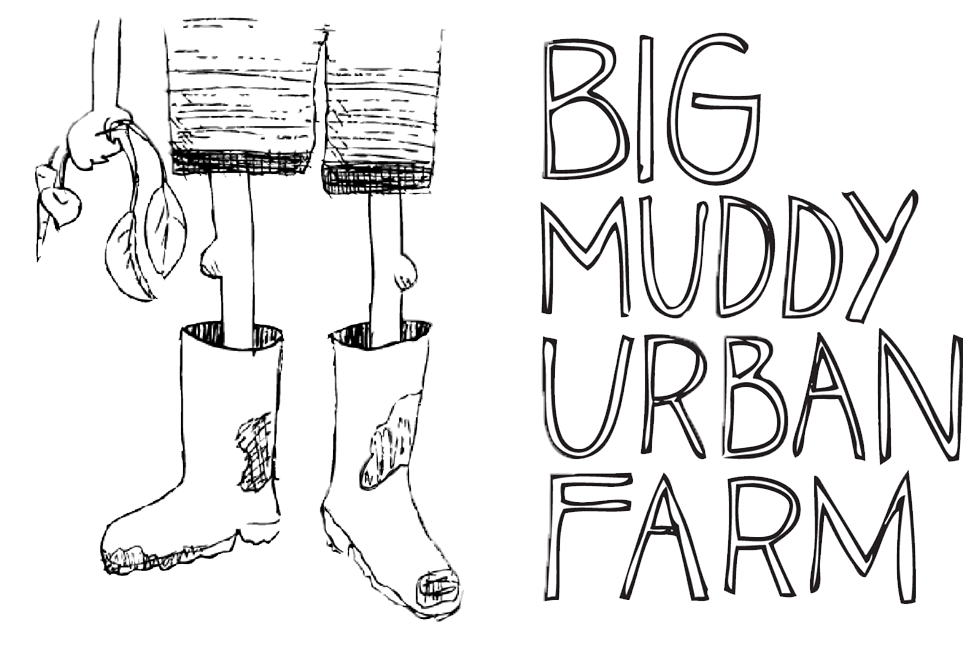How It Works
PURPOSE EQUATION
P = C [k + 5R (E + Fr + Fo + H + 7L) (≥20 hr/wk) ]
Purpose = Community [konstant + 5Residents (Education + Housing + Friendship + Food + 7 Lots of Land) (≥20 hours/week) ]
DEFINITION OF VARIABLES
Purpose.
- Keep our neighborhoods vibrant, safe and healthy.
- Connect, educate and inspire the next generation of agriculture.
Community.
The residency functions from the support of the community. Work is performed within the community to give a realistic sense of what the community wants and how to answer questions the community has involving the food system.
Constant.
The Big Muddy Resident Manager position is the constant. They see the farm year-over-year as it changes hands with residents to maintain good structure through the transitions. This person understands the history of the plots and relates necessary information to the residents, giving them the best tools to be successful. They know what has grown on the plots in previous years, good references and educational material residents should look into on certain topics and past farm business relationships. Additionally, they facilitate/manage the weekly discussion topics and track residents record keeping.
5 Residents.
Each year five residents are chosen from those who apply on the criteria of interest and passion in agriculture. Residents reside in a house nearby to the farm plots. Residents work together to develop a market farm business and go through the steps of propagating plants, seeding and transplanting plants, harvesting and bringing to market. The Program runs from the beginning of January through the seasons to mid-December. Application open in mid-Summer each year and residents for the following year are chosen in mid-October.
Education.
Based on an education method called process oriented guided inquiry learning (POGIL), residents learn in practice. By actually creating a business, propagating plants and developing relationships residents will be prompted questions throughout their experience to help them examine inquiries as they come up. As part of the weekly record keeping, residents are asked individual-centered questions to apply research and theoretical backing to this type of education. This puts a balance of theoretical knowledge with practical knowledge. Learning in practice.
Housing.
Residents do not pay rent for their housing as long as they are meeting their weekly educational and farming requirements. The reason to live in a house together is because an energy is created that makes for a larger experience than simply going to a class or performing a job duty. Residents are able to express and decompress their shared experiences of owning and operating a market farm in the informal times. Business communication is expedited and easier to manage by living close and while living together, learning through osmosis frequently happens reinforcing the quality of education.
Friendship.
Sustainable agriculture relies heavily on a support network between farmers. What better way to establish a supportive network than living together and becoming friends – going through the rough times and celebrating the good times together. An experience like this is sure to make life long bonds.
Food.
Residents can expect farm-produced food and some staples as long as they are meeting their weekly educational and farm requirements.
7 Lots of Land.
Residents grow on 7 plots of land all within a 1/2 mile of each other. Each plot has it own unique history and soil characteristic. This lends to a wide range of educational opportunities to learn from. Most of the plots had a house on it at one point in time, which eventually was torn down and leading to a neighborhood with many vacant lots. By using these lots to learn from, we are taking a community risk and turning it into a community asset. A safe place for all walks of life to stop by and ask questions about the food system we share.
20 Hours/Week.
The main requirement of being a part of the residency is to perform at least 20 hours field work each week. Off-farm employment is a reality to being a farmer according to USDA. We incorporate this realistic expectation into the residency by allowing for residents to take part-time jobs to supplement their income. We are developing an employer list for residents to quickly gain off-farm employment in areas like food preparation, other commercial farming operations and service jobs.
